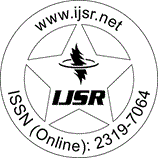Downloads: 120
Research Paper | Medical Microbiology | Sri Lanka | Volume 6 Issue 6, June 2017
Inducible Clindamycin Resistance in Staphylococcus aureus Isolates in a Community Setting
Harshi Abeygoonawardena [2] | Mahendra Gunewardane
Abstract: Background The resistance to antimicrobial agents among Staphylococci is an increasing problem. This has led to renewed interest in the usage of Macrolide-Lincosamide-Streptogramin B (MLSB) antibiotics to treat Staphylococcus aureus (S. aureus) infections. The resistance to macrolide can be mediated by msr A gene coding for efflux mechanism or via erm gene encoding for enzymes that confer inducible or constitutive resistance to MLSB antibiotics. In vitro routine tests for clindamycin susceptibility may fail to detect inducible clindamycin resistance due to erm genes resulting in treatment failure, thus necessitating the need to detect such resistance by a simple D test on a routine basis. Objective This study was carried out to determine the prevalence of MLSBi resistance in both S. aureus isolates, including Methicillin Resistant Staphylococcus aureus (MRSA) and Methicillin Sensitive Staphylococcus aureus (MSSA). Results Out of the 88 Staphylococcus aureus isolates, 18 (20 %) were MRSA and 70 (80 %) were MSSA.41 (47 %) isolates were erythromycin resistant. These erythromycin resistant isolates, when subjected to D test, 17 isolates showed MS phenotype, 13 showed inducible MLSB phenotype and 11isolates showed constitutive MLSB phenotype. Out of 18 MRSA isolates 08 (44 %) showed Inducible MLSB phenotype and 02 (11 %) showed Constitutive MLSB phenotype, while in 70 methicillin sensitive Staphylococcal isolates 05 (7 %) showed Inducible MLSB phenotype and 09 (13 %) showed Constitutive MLSB phenotype. The percentage of inducible resistance was higher amongst MRSA isolates as compared to MSSA isolates. Conclusions Clindamycin is kept as a reserve drug and is usually advocated in severe MRSA infections depending upon the antimicrobial susceptibility results. This study showed that D test should be used as a mandatory method in routine disc diffusion testing to detect inducible clindamycin resistance in Staphylococci for the optimum treatment of patients.
Keywords: Constitutive clindamycin resistance, D test, Inducible clindamycin resistance, MRSA, Staphylococcus aureus
Edition: Volume 6 Issue 6, June 2017,
Pages: 234 - 238
Similar Articles with Keyword 'D test'
Downloads: 0
Analysis Study Research Paper, Medical Microbiology, India, Volume 11 Issue 8, August 2022
Pages: 1411 - 1413Analysis of Different Tests for Diagnosis of Pulmonary Tuberculosis
Anita Kulkarni [3] | Dr. Kirti Dubey | Dr. Pallavi Wanjari | Dr. Yagnesh Thakar
Downloads: 1 | Weekly Hits: ⮙1 | Monthly Hits: ⮙1
Research Paper, Medical Microbiology, India, Volume 12 Issue 5, May 2023
Pages: 1706 - 1711A Comparative Study of different Diagnostic Modalities, ZN Stain, Culture and TrueNat for the detection of Pulmonary TB in Sputum Sample and To Study their Co - infection with HIV at a Tertiary Care Hospital
Arpita Kushwaha | Dr. R. Sujatha
